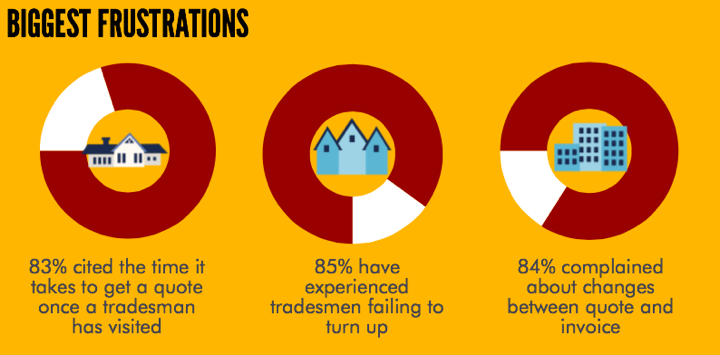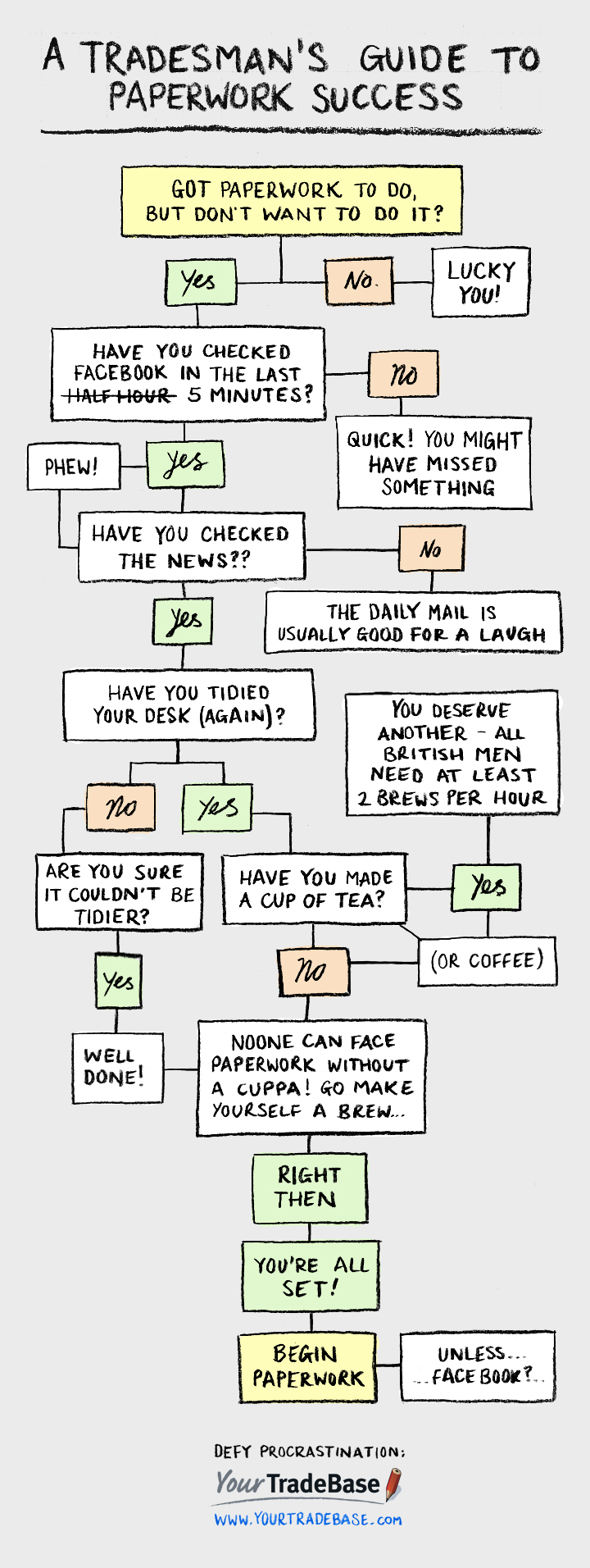What's new in YourTradebase?
How to win more work with a professional online presence
15 October 2014

A great online presence helps great tradespeople stand out from the competition and win more of the work they want. But how do you build a successful online presence?
FindaTrade.com share their top tips for tradespeople online.
It is widely accepted that the best way to find a tradesperson is through a personal recommendation from a friend or family member.
You know that when someone calls and tells you they have seen the work you did at their friends house and got your details from them, that you have a good chance of doing the work. They already have confidence in you and your services before they’ve even met you.
As you likely know, not all work comes this easily.
It is a competitive market and standing out from the crowd and quickly establishing trust and confidence with a customer can take time plus a little know-how.
With more and more people using the internet to find a tradesman, having a professional and detailed online presence is becoming key to tradesmen winning more work.
A well executed online profile can help bridge that gap in customer trust which does not come as easily when a personal recommendation has not been given.
What are the benefits of an online presence for tradespeople?
- Customers can find you 24/7.
- Your information is available at any time to potential new customers.
- They can learn about you and your business before they even contact you – this builds trust before you even speak.
- Showcase your business.
- Unlike other forms of marketing an online presence can present much more detail and information to potential customers.
- This enables you to tell potential customers about your services, what qualifications you hold, photos of your work, testimonials from previous customers and much more.
- Get rated and reviewed by your customers.
- Show people what others have said about you and your work.
- This shows you are willing to be accountable for the work you do and are happy to share the feedback and ratings you have received.
- You’re in control.
- Other than your ratings and reviews you are completely in control over your online presence.
- This helps you focus on exactly what is important to the customer and can even allow for some of your personality to show through which helps you to build rapport.
- You can also make changes and improvements whenever you like. If you’ve just completed a new job, upload the photos of the work to show others what you have been doing.
- Cheaper and more cost effective.
- Less and less people are reading printed press, preferring to use their laptops, tablets and mobiles to find information online.
- People are also fed up with being bombarded with leaflets through their letter box, most just get thrown straight in the bin.
- An online profile is cheaper (sometimes free) to set up and often has little or no costs going forward unlike advertising using newspaper ads, yellow pages and leaflet drops.
- Simple and easy to set up.
- Most companies offering these services provide a simple to use system which anyone can use.
- Support and help is also often available if required.
6 steps for tradespeople to create a successful online profile
A great online presence can do wonders for your business, however, get it wrong and it can actually harm you.
Presenting yourself in a professional, friendly and approachable manner is key to turning more leads into work for your business.
Here are our top 6 tips for a successful online profile:
1. Show that you understand what the customer is looking for
The first thing a customer wants to know is ‘do you do the work I require?’. If you do not (or they do not think you do) then they are not going to waste any further time looking at your profile.
Make it clear upfront who you are, what areas you cover and the types of work you carry out.
Show them that you understand what is important from their perspective, this includes (but not limited to); their satisfaction of your work, your respect for their property, the need for good communication and keeping them informed, providing a fast yet detailed quote.
Tip: A bullet point list of major towns/cities you cover and the type of works you do makes understanding your service easy.
2. Use photos to showcase your work
As they saying goes, a picture paints a thousand words. In this case, adding photos of your work will show more than you can ever explain in words.
Using before and after photos of your work is also a great way to show how your transformed someone’s home.
Tip: Add captions to the photos of your work to help explain what you carried out.
3. Use a system which allows for verified customer feedback
Using a system which allows for verified customer ratings and feedback helps your customers build trust in your business fast.
A verified feedback system is important because it means that they are independently reviewed by an impartial company so that customers know they are genuine.
It’s a good idea to ask some of your previous customers if they are happy to be available to speak with potential new customers about your work – this helps strengthen their confidence in you even further.
Tip: Use your best customer feedback comments as standout testimonials in the main section of your profile.
4. Keep your profile up to date
By keeping your profile up to date with recent photos, ratings/feedback and testimonials show that you are still an active business and someone who is consistently achieving good ratings and having happy customers.
This only needs to be done every few months and is most cases does not take long to do.
Tip: Adding dates to your photos of work helps show how recent they are.
5. Show willing to offer help and advice
To help get a person invested in you and your business it is good to offer them something for free which they still find valuable.
This can be done by telling people you are happy to provide help and advice on projects even if they do not end up choosing you to do the work.
This shows you are happy to help people, but are not pressuring them in to using your services – in the long-term it often means that they do because they are pleased with the help you have provided.
Tip: When quoting, explain to customers that if they receive other quotes they should make sure they also include x, y and z. This shows to them that you understand what is required and if other companies do not include this information they will often choose you because they know you understand the work better.
6. Use a professional looking profile system
No matter what you do or say in your profile if it does not look professionally done it will detract from your message.
As with most things humans are visually responsive and it is no different with an online profile page. Make sure you use a system which provides you with a detailed and professional looking profile which is eye catching but also easy to read.
This is also true of any photos you upload, make sure they are in focus, well lit and of course the right way up!
Tip: If you are not good with photo editing ask a family member or friend who is to correctly, crop, position and resize your images so they fit well in your profile.
Get your business online and create a professional profile to win more work
A professional online presence really can make the difference to you and your business.
It is also very useful to use a site which will be able to provide you with job leads along with a profile. Not only do they help to find you more work but you will get verified ratings and feedback comments for the work you carry out added to your profile.
This article was written by FindaTrade – the best way to get the work you want, when you want it.
 If you’re a tradesperson looking to create a professional online profile and receive local job leads tailored to your needs then you can join FindaTrade for FREE here.
If you’re a tradesperson looking to create a professional online profile and receive local job leads tailored to your needs then you can join FindaTrade for FREE here.
A 90-Second Video Introduction to YourTradeBase
14 October 2014
Watch our quick new video and see a smarter way to sort your paperwork for yourself.
Start a free 30-day unlimited trial today
How to follow up on your customer quotes more easily
17 September 2014

Is your workload up and down like a yoyo? You’re not alone. It’s often unavoidable that your amount of work will fluctuate up and down, but how can you make sure that work stays constant?
YourTradebase co-founder Dean Taylor shares his experience of managing an up and down workload:
At present my work load seems to be up and down like a yoyo.
One day I have weeks of confirmed work, while the next I’m running low and starting to sweat.
This series of ups and downs has made me realise just how important it is to constantly chase new work to make sure work stays constant.
I seem to take my foot of the gas when things are looking good only to regret it when they aren’t.
An up and down work load means it’s vital to be constantly chasing up on new customer quotes. Tweet this
When you work in a trade that doesn’t really allow for repeat business from the same customers, chasing new work needs to be a huge part of your weekly job list.
Following up on quotes needs to be done regularly, even when the answer you get from customers is a ‘No thanks’.
To help me with this, me and the boss (the wife!) have drawn up and documented a workflow process that covers all scenarios from answering the phone or replying to an online enquiry through to where we file any work associated paperwork once the job has been completed.
A huge part of this workflow is how and when we deal with any quotations sent but where we haven’t yet had a response, from potential new customers.
We now send out a letter approximately 7 days after the quotation was sent to all customers that have not responded. This allows us to display a level of professionalism and provides us with a great marketing opportunity.
Whilst brainstorming this sales/workflow process I sat down and rummaged through my file of outstanding quotes and was sick to the stomach once I realised that since the beginning of June I had distributed 21 quotes that remained, as I call them, ‘awaiting response’.
If I had this process in place from day 1 and followed it strictly every week I probably would never get to the stage of work drying up or getting close to.
Yoyo’ing workloads can be managed, but it means having some simple processes in place to make sure you’re always closing new work opportunities.
Now the chase for me is never ending and I am looking forward to seeing the benefits of this simple and easy to do task.
Dean’s top 7 tips for chasing customer quotes:
It might feel as though you’re ‘badgering’ your potential customer, but a well timed and well thought out follow up can help you do exactly what you need it to do – get an answer on a quote you’ve sent.
1. Know when your quote was sent
Make a note and keep it in your diary. It’s important to know how long has passed since you sent it, then you know exactly when to chase it – it’s often timing that can help you win that customer round.
If you’ve used a template, make sure you update the quotation date to reflect today’s date! Learn how a quote template could help you.
Also make a note if they have someone else coming round to size up the job as well, then you know how long you need to leave them after that. If you’re not sure ask, and explain it’s because you want to give them enough time to mull it over.
Most customers will appreciate your forethought.
2. Let your customer know when you’ll be following up within the quote or when presenting the quote.
“We’ll be in touch in a week to see if there’s anything else you need – or to answer any questions you have” – this way they not exactly when to expect it, and they’re not put on the spot if you ring at an unknown time.
Plus if you ring/chase up exactly when you say you will it also helps show consistency and professionalism.
3. Find out the preferred time and method for contacting your customer.
Post, email, phone, SMS? What’s the best time to call – evening, weekend?
Let them make the choice and keep a track of this in an online or offline address book.
4. Set yourself a reminder to for 7 or 14 days after you send the quote.
Decide how long before want to follow-up and set yourself a gentle reminder. It’s easy to forget about chasing quotes if you have lots of work on, or if you are quoting lots of different projects.
If you’re busy, time slips by and before you know it, weeks have passed. Set yourself reminders and take away the worry about following up!
5. Calling customers: don’t chase, ask if you can help.
Ask your customer if they need anything else or want any help understanding your quote, don’t pressurise and keep it neutral.
Most customers won’t know much about the technical aspects of the job you’re doing, so they’ll appreciate any help you can offer.
6. Keep notes on all your conversations
You have a lot on your plate – don’t add to it by trying to remember every facet of every conversation… keep track of key conversations and things that have been agreed. It’ll stop you from getting stressed and possibly from letting your customer down.
7. Power of the post!
Send a follow-up to your original quote with testimonials and your full terms: most customers appreciate the chance to mull it over and read through, rather than having a conversation. So use this to your advantage!
Bonus: Win or lose… get feedback!
Regardless of yes or no decision, there’s things you can learn to improve your next quote: what could you have changed to have won the work -or- what would have helped them make up their mind quicker? Always learn – you never know it could be the simplest thing that you need to change and you’ll find the work flowing in!
Getting paid on time: how do you make sure customers pay on time?
3 September 2014

You do a great job, have a happy customer, then wait to be paid… then you wait some more… more waiting and still no money.
Waiting to get paid doesn’t help you or your business. Here’s how small changes can help you start getting paid on time.
There’s a business mantra that “Cash is King“. Looking after your businesses cash flow is all-important to the health and success of your business.
But what happens if you end up waiting weeks to get paid the money for jobs you’ve already completed (and probably paid out for materials and labour for)?
Here’s why not getting paid on time hurts you and your business – and how to make sure you do get paid in good time.
Are you getting paid on time?
A recent survey of 10,000 tradespeople shows that the #1 tradesman’s frustration is not getting paid on time. (Source: Ironmongery direct survey)
It’s also been estimated that UK tradespeople could be owed up to £2.5 billion each year by late-paying customers, according to this report by WorldPay.
According to that report, builders (88% suffer late payments) and plumbers (90%) are the worst affected tradespeople.
With such a large number of tradespeople having to wait for such large amounts of money, it’s no wonder late payments top the list of tradesmen’s frustrations.
It’s likely to be very damaging to morale, lifestyle and business cash flow, too.
Why getting paid on time is important to your business
Other than late payment from customers being frustrating, there are other ways it impacts you and your business:
- Late payment affects cash flow. We’ve already mentioned the importance of cash flow. It’s imperative that cash flows through your business to allow day to day operations to continue unaffected. Late payments make this difficult.
- Time spent chasing payments could be spent elsewhere. Phone calls, visits, letters. Even relatively small actions to chase late payments eat into your valuable time and add up to time you could – and should – be spending on other things.
- Your salary suffers. If your salary is directly linked to the cash your business generates, then going without personally after completing work isn’t fair or fun.
- Worrying about cash is stressful. Just like the time you spend chasing late paying customers, you’re also wasting a whole lot of energy too. That’s energy that is better spent on growing your business.
So, we know that late payment is a big issue for tradespeople and their businesses, but what steps can be taken to try and avoid – or at least minimise – late payments…
7 Tips for getting paid on time
Here are our 7 top tips to help tradespeople get paid on time from their customers:
1. Invoice promptly
Sounds obvious, but if you’re expecting to be paid, your customer probably expects to know about it!
Make sure you have a system in place to allow you to send invoices quickly and easily when you need to.
Outlining the exact work you’re invoicing for will help make sure there’s no room for debates about what the invoice covers – which could normally lead to time delays.
If you’ve set up staged payments on a larger project, then set yourself reminders (using your calendar or invoicing system) of what’s due and when.
Even better, create all the invoices for staged payments at the start of a job, with their expected due dates and make sure you’re able to receive notifications from your tradesmen invoicing software when those invoices are due to be sent.
Sending invoices on time should minimise waiting time for payment, and shows your customer you expect to be paid! Tweet this
2. Set a due date clearly on your invoice
As well as presenting an invoice with a good level of detail, be sure to clearly state on your invoice when the payment is due. Do you offer 7 days payment terms? 14 or 30 days? Or do you expect immediate payment?
Delayed payments might arise from customers not realising that payments are due within a set time period, so try to avoid this situation.
It’s also worth including on your invoice the methods available for payment to be made.
Make it clear to your customer when and how to make payments to you if you want to be paid on time. Tweet this
3. Set clear payment terms when quoting
As we stated above, your customer expectations can be a big factor in late payments.
If customers aren’t entirely clear on what your expectations are, they could think delaying a payment by a few days or weeks is no big problem.
To avoid this, make sure that payment terms are part of your quoting process.
Be clear on what payments you expect, when they need to be made and by what method within your quotes. When your customer accepts the quote, they’re also entering into an agreement on their side to meet the required payments on time.
Setting a clear payment schedule when quoting for work helps avoid potential payment issues in the future. Tweet this
4. Be clear on amounts from the start
Gillian Guy, the chief executive of Citizens Advice:
“Disputes often arise when there is a lack of clarity around how fees have been calculated and who pays for materials or travel costs. To try to avoid this, it is really important to agree what you are paying for in advance, and get it down in writing so that you have the evidence if there is any disagreement later on.”
Make sure a ‘lack of clarity’ doesn’t lead to late payments from your customers.
Be clear on all costs when quoting for new work, and also be clear on any estimated costs, or possibilities where extra costs will be incurred.
Are you charging for travel time? Make sure your quote always clearly outlines exactly what is – and isn’t – covered in the costs.
Be clear on what you’re charging for what work – and make sure it’s in writing – to avoid late paying customers. Tweet this
5. Keep your finger on the pulse of your business
You should know how your business is performing and be able to answer some common questions if you want to minimise the impact of late payments.
What payments are due to be invoiced this week?
What payments are now overdue, and by how long?
What payments have you received this week?
By knowing the state and health of your business, you’re much better placed to avoid the issues (and stresses) that late payments might bring.
Make sure you’re invoicing solution gives you a clear idea of what’s what in your business at a glance.
Don’t leave it until it’s too late to get a handle on your businesses cash-flow.
To minimise the impact of late payments that might arise, it’s vitally important that you know your business. Tweet this
6. Define a simple process for chasing late payments
If you accept that late payments are going to happen from time to time, then being prepared to deal with them will save you time when it does happen.
A simple process for dealing with late payers could include:
- Draft a letter or email that you can re-use when you need to chase late payments.
- Have a system that alerts you when payments are overdue.
- Set a reminder of when to follow-up a letter or email with a phone call.
- Decide what – if any – your escalation procedure is going to be.
Be prepared to deal with late paying customers professionally and reduce your stress and wasted energy! Tweet this
7. Deliver great work to agreed works details
Of course, the best way to avoid late payment is to not give your customers any excuses by delivering great quality work!
If you’re on time and deliver agreed works to a great quality, your customers are going to have difficulty in finding a reason to delay payment.
Aiming to make your customers ecstatically happy with the work you deliver is a great way to avoid late payments, and makes great business sense, too!
It could also mean getting your work ‘signed-off’ at each stage of the job. By making sure your customer agrees the work is completed in ‘stages’, there’s much less room for complaints or upset leading to delayed payments when the job is finished.
Agreeing scope of work in advance and having the customer sign-off at milestones can help avoid late payments. Tweet this
My customer is refusing to pay… what next?
If a late-payment is starting to look like a non-payment, things can get a little more serious.
Here are some resources that should lead you to some help and advice on what to do next:
- Government advice on dealing with non paying customers: https://www.gov.uk/invoicing-and-taking-payment-from-customers/payment-obligations
- Contact your local branch of citizens advice: https://www.citizensadvice.org.uk/
- Advice from Business Know How: https://www.businessknowhow.com/money/wontpay.htm
- Advice from lawdonut.co.uk: https://www.lawdonut.co.uk/blog/2013/04/when-customers-wont-pay
– – –
Getting paid late can hurt your business and it’s cash flow. Take some simple steps to minimise the effect that late payment has on you and your business.
How quicker quoting can help you win more work
27 August 2014

You’ve surveyed the new work, given a good first impression, and know you can give a great price. You’ve agreed to quote as soon as possible… but is that soon enough and should you be quicker when quoting?
Paperwork can be a tradesperson’s worst enemy. Getting quotes done should be one part of paperwork that you make as easy, and as fast, as possible.
Here’s why quoting more quickly makes sense – for you and your customer – and how to start getting it done faster than your competition.
Why is quicker quoting great for your (business) health?
Whether or not you use estimating software for your quoting, a customer expects to see your quote promptly.
Do you get your quotes done within 1 day of seeing a new customer?
3 days?
7?
The longer you take to get your quote into a new customer’s hands, the more you could be harming your business.
Here are some reasons why quicker quoting can be better for you and your business:
Slow quotes cause customer frustration…
A quick search around the web shows there are lots of homeowners frustrated by waiting ages for quotes from tradesmen.
Here are just a few… from mumsnet: tradesmen should come back with a quote quickly, from singletrackworld: chasing tradesmen for quotes, and from mybuilder: How long does it take for tradesmen to quote?
If it frustrates customers enough to vent online, we can imagine that this is a very real problem.
Indeed, a survey by Ironmongery Direct shows that 83% of customers are frustrated with slow quotes from tradespeople:

www.ironmongerydirect.co.uk run a poll of 10,000 customers and found that 83% of customers get frustrated by the time it takes for tradesmen to get a quote to them.
If you’re slow to quote, you could be frustrating customers. Quote quicker for happy customers! tweet this
Beat your competition…
There’s a strong chance that your customer is asking for quotes from several sources.
You will be compared with the competition, and the time it takes you to quote (as well as the professionalism of your quote) is very likely to be considered.
With so many tradespeople taking a long time to quote (or not even turning up) there’s a huge opportunity to beat the competition off the starting block.
Set the bar and the standard for your competitors to meet when quoting.
Quick quotes = efficiency and professionalism. Set the tone and beat your competition. tweet this
Get it off your plate!
You’ve got a lot on your plate and mounting paperwork just adds to it.
Quoting for new work might seem very easy to put off (you could have plenty of work right now, after all) and can easily become a “tomorrow task“.
But… that mounting pile of quotes is very likely to add a huge amount of stress to your days.
A good system for quoting gets quotes out quickly and save you a headache! tweet this
Win more of the work you quote…
If quicker quoting means: happier customers, a great impression and standing out from your competition, then there’s a much improved chance that your business will win more work.
At the very least, sorting your quotes quicker and getting them off your plate will save you time and mean you can earn more during your working day.
Here’s how quicker quoting helped The Loft Boys:
“I’d say that 95% of the quotes we send to customers are now produced on the same day. We use YourTradebase job management software to easily manage all this. This has led to a time saving of around 1 hour on each quote and we’ve seen our win rate increase by around 30%”
(Disclaimer: The Loft Boys is owned by Dean Taylor, co-founder of YourTradebase)
If you could send out quotes within 24 hours of surveying new work, how would that impact your business? How could you make sure that always happens?
What slows down your quoting the most?
The first step to quicker quoting is to recognise what makes quotes a lengthy task for you in the first place.
Perhaps it’s due to one of the following:
- Lack of time. Spending evenings surveying new work and then getting onto paperwork could be your biggest issue. Can you prepare most of quote whilst you’re surveying?
- Wrong tools for the job. Working on a PC word processor isn’t fun and can take far too long. Are you using the right tools to quote?
- Waiting on partners. If you’re wife or partner does your paperwork, you could be waiting on them to decipher your notes and type up your quote!
- Waiting for materials/labour prices. To quote accurately, you could be waiting too long to get prices for materials or specialist labour.
- Tired after a long day on the job. It’s also likely that after a long day on the job, quotes are taking longer than they need to as your brain is switching off!
Think about what aspects of quoting slows you down the most. Identifying the problem means you’re more likely to solve it.
5 simple steps to start quoting more quickly
Here are 5 tips that most tradespeople could implement to start getting quotes to customers more quickly.
1. Know your prices
Speed up your quotes by knowing what you want to charge for your time.
Calculating an hourly rate is straightforward (here are 5 simple steps to easily work out a tradesman’s hourly rate) and means you just need to be able to accurately estimate how long work will take you.
Quoting then becomes a simple job of working out how long each piece of work will take and multiplying it by your hourly rate.
Once you know your labour charge, work out how much you need to markup materials to cover your time and expense in sourcing, ordering and collecting them.
Knowing – and using – your own pricing strategy in this way can be a quick way to speed up your quoting process.
2. Using a quote template is quick and easy
Why wrestle with Word or handwrite quotes each and every time you need a quote?
The time wasted on typing up your quotations can be spent much more effectively earning money or relaxing!.
Grab yourself a Estimating software and save yourself hours typing up information for your customers.
By using a template for text like why customers should choose you, your standard terms and conditions and payment schedules, you can save yourself time re-typing information.
3. Email your quotes (…and make sure they land)
Email is a near-instant way of delivering your shiny new quote. So you don’t lose time waiting for post to be delivered.
It’s also less work for you – no printing, envelope stuffing, posting or delivering; instant delivery at the click of a button!
Make sure you get your customers email address and tell them to expect an emailed quote from you and give them a timescale.
But… don’t just email and forget it! Follow up with a call after a day or 2 to make sure it’s been received.
Oh, and check your emails as often as you can to make sure your potential new customers haven’t asked a question about the quote that you’ve ignored!
4. What’s the delay? Quote today!
There’s a reason people say:
“Strike while the irons hot”
Getting a quote created and to your customer the same day has a few advantages:
- The details of the work will still be fresh in your mind.
- Customers will be impressed with your professionalism and efficiency.
- You keep your workload to a minimum by not letting quotes build up.
One way to help quote the same day is to make sure you don’t have to wait until your at home and in front of a PC to quote.
Make sure you can get working on your quote straight away: If you use an app, you can spend 10 minutes in your van after a survey (or after taking a phone call for new work) and create a quote from a template and email it right away.
Even if you can’t quote an accurate price, try to give an estimate or idea of price. this is also a good way of gauging if the price is what the customer was expecting and let’s you set expectations early on.
5. Learn from previous work you’ve won
Try to make a habit of archiving your old quotes for prosperity – and make sure you can easily search the contents of your old quotes.
That way, you can easily search back to similar work you’ve priced.
Chances are, you’ve already done most of the typing for the job you now need to quote, so re-use that wherever possible.
Looking back over previous quotations is also a good way of checking you’ve thought of everything that your customers needs for the work you’re now quoting for.
– – –
Quicker quoting is great for your business and keeps your potential customers happy. Start jobs off the right way taking steps to speed up your quotations.
5 steps to calculating your hourly rate
25 August 2014
Having an hourly labour charge places an actual price on your time.
An hourly rate will make working out what to charge for your labour a much easier task…
But how do you know what to charge per hour?
Here’s an easy way to work out how much you should be charging per hour:
- Write down the annual salary you want/need to earn. That’s your desired salary.
- Minus the number of holiday weeks you want each year from 52. That’s the number of weeks you’ll work each year.
- Divide your desired salary by the number of weeks you can work. That’s your weekly earnings target.
- How many hours do you want to work each week? Divide your weekly earnings target by the number of hours you want to work.
- That’s your hourly rate. Write it down and keep it in mind… Always aim for it!
When pricing new work, multiply your hourly rate by the estimated number of hours you estimate it’ll take to complete the work.
– – –
How to price your building work competitively and still earn money
20 August 2014

Pricing your building work can feel a little like Goldilocks… price too high, no work. Price too low, no money. Pricing just right… tasty!
Getting pricing right is a difficult balancing act.
Here’s a guide to more easily work out what you should be charging for your next job.
How much detail should you include with your price?
It’s entirely your choice how much work detail you provide with your price. However, including full detail on the work you plan to provide can ensure:
- Your customer is fully aware of what is – and what isn’t – included with your price.
- Potential disputes are easily resolved by referring to the works details.
- You have a sanity check that you’ve priced for all required works.
- When comparing your price to other tradesmen, your customer can easily see whether it’s a ‘like-for-like’ price.
- It sets the tone. Your customer will be more confident that you’re thorough with your work if you’re thorough in your pricing.
It might take a bit of extra time (unless you’re using software for estimating), but providing more detail can give you an edge.
General things to consider when providing a price
The Department for Business Innovation & Skills have put together a best practice guide (you can read the PDF here).
It’s a lengthy document, but if you’re pricing for building work, here are a couple of key takeaways:
- If you charge VAT, always include the VAT amount or rate. If you’re providing an estimate, you should indicate that if the price varies, the VAT amount will vary too.
- If you’re charging a minimum call-out fee, you should make sure your customer knows what it covers, and make them aware if the price might be higher if additional work is required.
What goes into a price?
Here’s how most tradespeople arrive at a cost for building, construction, plumbing or electrical work:
Labour + materials + profit = job price
So, how do you make this formula work for you?
Calculating your labour cost using an hourly rate
Knowing your labour charge is simply placing a price on your time.
That’s where hourly rates become a valuable tool.
Having an idea of your hourly rate will make working out your labour a very easy task… but how do you know what to charge per hour?
Here’s an easy way to work out how much you should be charging per hour:
- Write down the annual salary you want/need to earn. That’s your desired salary.
- Minus the number of holiday weeks you want each year from 52. That’s the number of weeks you’ll work each year.
- Divide your desired salary by the number of weeks you can work. That’s your weekly earnings target.
- How many hours do you want to work each week? Divide your weekly earnings target by the number of hours you want to work.
- That’s your hourly rate. Write it down and keep it in mind… Always aim for it!
When pricing new work, multiply your hourly rate by the estimated number of hours you estimate it’ll take to complete the work.
Remember to include travelling time when adding up your hours for a job.
Working out (and marking up) your material costs
The next part of our pricing formula comes from the materials you’ll need to buy to complete the work.
Hint: keep an accurate note of the materials you include in your job price. It’ll be your material shopping list if you win the work, and you can also compare it to the actual materials you then use to learn from and improve your future prices.
Create a list of the materials you’ll need to complete the work and include the total cost into your quote.
Don’t be afraid to markup the materials – after all, you should factor in the ordering, selecting and handling of those materials in your pricing.
Of course, if you can save time and money by getting materials delivered to site, then by all means don’t worry about marking up materials costs.
If you’re happy with your customer purchasing materials, then make sure you include a hourly charge for drawing up the list for them to buy.
Don’t forget that profit is sanity
There’s a great business saying that goes: turnover is vanity, profit is sanity, cash is reality.
You’re in business to make money, so profit has to feature when working out your building work price.
Here are a few costs you should consider when deciding how much ‘profit’ to make on a job:
- Your business accounting and administration costs.
- Telephone costs.
- Petrol costs.
- Advertising and marketing costs.
- Tools and clothing
- Over-run on jobs
All of these things costs you money. The work you complete should be enough to cover these costs.
Here’s a simple way to make sure your business stays profitable through pricing:
Total all of your monthly running costs and expenses, divide them by the number of days you work each month, and you get a daily cost of running your business.
At the very least, the ‘profit’ you make on a job should cover your basic daily business expenses.
Add the profit you need to make to your job pricing.
Never, ever, get into a price war
Avoid competing on price with your competitors at all costs… A race to be the cheapest is no way to run a business!
Your customers don’t solely concentrate on price when choosing a tradesperson. There are other factors involved…
Here’s some advice from The Federation of Master Builders:
Q: Should I always go with the lowest quote?
A: We don’t recommend that you always go for the lowest quote. You need to find a builder that you’re comfortable with, and also in terms of the value that they’re going to do.
Make sure you focus on your unique value. This will help you avoid getting into a price war.
Your unique value should be the quality and professionalism of your work.
Write down the 2 or 3 things that make you a business your customers will want to use (for example: timekeeping, professionalism, expertise, guarantees). Make sure you communicate your value to your customer.
If your perceived value is greater than the perceived costs, your customers will be motivated to act. Create value. Click to tweet this
How do you know how others are charging? Here’s a handy list of average costs for basic building work for homeowners.
Don’t undersell yourself – your customers would much rather pay for honest, reliable expertise.
You’re working to earn money. So, make sure you have a pricing system for your building work that makes sure it’s worth your while.
How to win more work from your leads
13 August 2014

You’re working hard every day and producing great work. Your phone is ringing and your trade services are in growing demand. But, are you making the most of your tradesman leads?
What do we mean by ‘lead’?
A lead is a potential customer that has been in touch about you completing a job for them.
Why are leads important for tradespeople?
For most trade businesses, regularly winning new work is vital to business success (and a healthy bank balance!). New work typically comes from the leads that a business is able to generate.
So leads are essential to winning new work.
Making the most of your leads will lead to more work and help you maximise your earnings.
What goes into getting a lead?
Getting new leads requires at least one of the following:
- Time
- Money
- Effort
Even if you don’t spend much money or time getting new leads and you rely on good old-fashioned word of mouth, that word of mouth has been generated on the back of the good – hard – work you do. So, even word of mouth costs effort.
Most other methods for getting leads costs money (think advertising, sign-written vans, websites, lead generation sites, social media, walking around with a sandwich board… ok, maybe not that one…).
Once you’ve got a lead, time and effort will generally be spent on trying to win the work.
If you’re spending time, money or effort on something, make it count…
Getting leads costs your business in some way; so it makes sense to make the most of them once you’ve got them.
Working a little smarter can help make sure you get the most from your leads.
Getting more from you leads = winning more work + business growth + maximising earnings


Here are 6 easy ways to start getting more from your leads today:
1) Tell your lead what’s happening at every step.
Kids are scared of the dark and when they grow up to be your potential customers, that fear remains! The moral of the story? Don’t keep your customers in the dark.
Your leads are looking to hire you for work they probably don’t know how to do themselves. Getting that work done by a tradesperson isn’t something they’re comfortable with. It feels like the unknown.
Making them feel comfortable will give you an edge over your competition.
Making sure your (potential) customer knows what’s happening – and when – will make them feel more comfortable about the work you’re trying to win.
Help to build the trust of your customer by:
- Let customers know what your exact process is as soon as you can. Perhaps it’s something like: survey > quote > follow-up > agree date/confirm work > start work.
- Let your customers know exactly when things will happen. Then stick to it!
- Let your customer know what they can expect from the quote – how much detail will it contain, will there be a breakdown of prices, how can they ask questions about the quote.
Helping your customers feel comfortable about the work you’re going to do for them is the first step in building a relationship with them.
It also shows them the level of professionalism they can expect to find in your work.
2) Set yourself reminders to never break your promises.
Your customer will be comparing you to your competitors. Whether you like it or not, you’re being compared.
Make sure you stand out by doing what you say you’ll do, when you say you’ll do it.
Sounds easy – and it can be – but you need to be disciplined and check your tasks and reminders daily.
There are lots of free apps available that help you keep track of daily tasks and todos, or you can use your phones’ calendar function to keep track of them.
Allergic to smartphones? Keep a small diary in your van to note down on the day you’ve agreed to do things. (oh, and go see a doctor about that allergy – working smarter with your phone can be great for your health!)
Having a routine to remember what needs to be done and when will help you stand out against your competitors.
3) Sweat (and remember) the details.
When you first take a phone call, or survey for potential new work, it’s easy to think you’ll remember details you’ll need when you come to quote for the work.
Why make it so hard for yourself!
There’s no need to keep all the details on your mind (you’ve got enough going on!), so keep notes of the work that needs doing, any customer requests, or anything you need to remember.
It might be several weeks before you speak with the customer again, so having your notes to hand will make things easy for you.
If you’re surveying work, you could take photos on your phone or tablet of the work for you to refer to later.
4) Quote more quickly (and more professionally) than your competition.
Your leads will likely be getting quotes or estimates from several tradesmen.
You’re in a race to impress your lead and show them you’re the business for the job!
Set the best impression – and beat your competition to the finish line – by getting your quote to your customer as fast as you can.
Show your lead how easy it will be to work with you.
Getting a quote to your lead quickly doesn’t mean more late nights and stress.
You can easily quote more quickly to beat your competition with less effort. Here’s how:
- Use a pre-designed quote template to create quotes more quickly. There are plenty of templates available on-line, or you can use a quoting software tool.
- Define the services that you offer ahead of time. That way, you just need to pull them into your quote to use them, rather than writing them out from scratch each time.
- Identify the work you always do. For some services you might be able to write out the details of the work that are generally the same, and just change or add what you need.
- Try using tools that allow you to write some of your quote whilst you’re on site – using a tablet or smartphone.
- Capture an email address from your customer so you don’t have to worry about printing, posting and worrying about it getting there.
- Follow-up in 2 or 3 days to make sure the lead got the quote – and see if they have any questions about the work.
Quoting smarter can save you hours and win you more leads.
5) Don’t give up on lost leads.
If your customer doesn’t decide to go ahead with the work they contacted you for, make sure the lead is not wasted.
It takes time, effort and money to generate new leads, but reaching out to previous leads is a much cheaper way of winning work.
And, they could still be a hot prospect for work in the future.
How can you win work from leads in the past? Chances are, you’ve spent some time talking with your old leads, so you’ve already started building a relationship with them. They’re also bound to need your services (or know someone who does) at some date in the future.
Set yourself a reminder to follow-up with them (an email or letter in the post will do) in 3, 6 or 12 months time and remind them you’re there if they need you.
If you have a lead that you don’t hear from, don’t just let it go. Have a plan to follow-up with them.
You’ve spent a lot of time, energy and money on that lead – don’t let it go cold! Schedule a follow-up for leads you haven’t leads.
6) Make it easy for your leads to reach you…
So you’ve done everything right and given yourself a great chance of winning that work… great!
Now make sure your leads can get in touch with you!
If you have a contact form on your web site – or you give out an email address – make sure you check for new mail regularly. You don’t want to miss a customer question or the green light to go ahead with new work.
The same thing goes if you have a business Facebook page or Twitter account – check it frequently as your customer might be trying to reach you there.
Oh, and if you can’t answer your phone, make sure you have a voicemail message that re-assures your customer they have the right number, and return calls promptly!
– – –
Leads are vital to your trade business. Some small changes can help you make the most of them and will generate you more work and maximise your earnings.

Who uses YTB? Tyrrell’s Plumbing Solutions
12 June 2014
Robert Tyrrell takes a few mins out of his busy workday to tell us how he uses YourTradebase:
What’s your trade?
Plumber
What’s your company or business name?
Tyrrell’s Plumbing Solutions
How does YTB help your business?
That’s easy; The fact that I can access my customer database, invoices, and quotes in any location where I can connect to a wireless network or 3G makes YTB an invaluable part of my working toolbox.
I love using the software. I can actually send an invoice from my iPad, phone or computer while I’m out and about, and my secretary (The Wife) can do the same from the office (home), and all my contacts/quotes/invoices are stored remotely, which gives me added piece of mind in case my computer pack up working.
Definitely recommended.
How much time does it save you each month?
Probably about a day at the moment, but it also saves my admin assistant (My wife) a round the same amount of time as well. She can also use it to help schedule work as she can see what job I’m currently working on, and it helps her with chasing unpaid invoices.
Tyrrell’s Plumbing Solutions – Warwickshire – www.tps.me.uk
5 reasons you should be using apps for tradesmen
5 June 2014
We know how it goes, you’ve got the smartphone, 3G or 4G wherever you are, and the world at your fingertips… But how does this actually help you?
Well by using apps specifically for tradesmen you can help boost your efficiency, keep track of everything you’re doing, save time, stay ahead of the game, and even win more work! But how exactly will these tradesman’s software do that for you?
1. Save time – many apps for phones now means you can update work, paperwork and schedules all at the touch of a few buttons. Meaning you don’t have to go back to the office or wait until later if you need to change something.
2. Increase efficiency – by saving time you’ll also find this will start to extend to other areas of the business. By keeping information in an app on your phone you’ll be able to work from anywhere, leading you to increase your efficiency.
3. Be better organised – they’ll allow you to have everything at your fingertips, meaning you’ll never forget anything again (apart from maybe that one tool you need!).
4. Work from anywhere – you won’t need to tie yourself down, meaning you can be much more relaxed about where you have to work, meaning you’ll probably be in a much better state of mind, meaning that you’ll find any paperwork or odd jobs that you do have to do will be easier to do.
5. Tools on the go – forgotten your spirit level? No problem! Haven’t ordered a part? No problem! There are apps for that.
So now that you know why you should be using app, what tradesmen apps should you be using? Well luckily we’ve got a list for that too!
– The iQuick Contract Maker allows you to quickly and easily create a legal contract on site or during meetings with customers, making the relationship between tradesman and client stress-free.
– The TrustMark App looks to bridge the gap and assure customers that they will be in reliable hands, as well as protected by evidence should anything become disputed or end in disagreement.
– Rated People – by being registered on their site you are putting yourself and your trade onto a mobile database accessible by anyone using the app, possibly providing you with new business links and asserting yourself as a reputable tradesman in your area.
– iHandy Level– Forgotten your spirit level? No need to worry, this handy app has a built in spirit bubble and is downloadable to your mobile.
The Construction Calculator– No tradesman wants to spend his time try to convert measurements from metric or imperial and back again. The Construction Calculator works as a your standard industry calculator but allows you to work in yards, feet, fractional inches and millimeters, converting between all types at the click of a button.
Got an app you’d like to add? Let us know!
Looking for construction software or software for plumbers? YourTradebase has your back!



